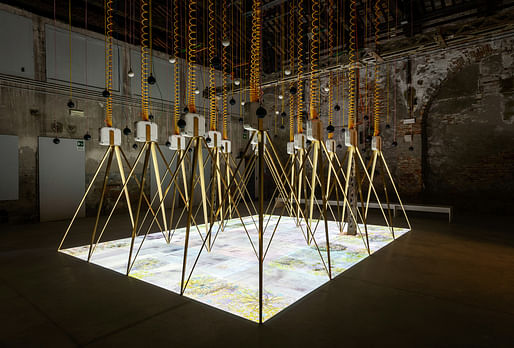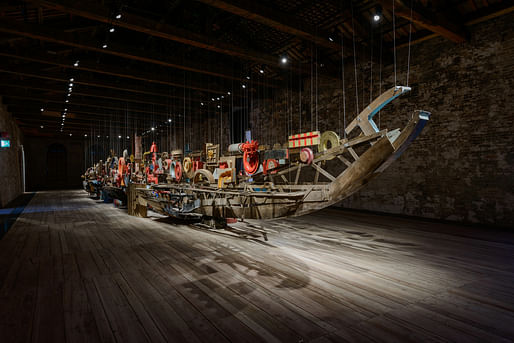
Planning your last-minute trip to Venice for the final days of the Architecture Biennale? Or would you prefer a redux, virtual version of the mega-event's best parts? Here's your CliffsNotes version of Alejandro Aravena's Biennale, from the comfort of your own screen:
First off, Chilean architect Alejandro Aravena (also the winner of the 2016 Pritzker) was selected to direct the Biennale in 2015, with hopes to exhibit “success stories worth to be told and exemplary cases worth to be shared where architecture did, is and will make a difference in those battles and frontiers". He later fleshed out the theme a bit under the title "Reporting from the Front", which many participants latched on to by addressing the Syrian refugee crisis, housing shortages, post-industrial cities, climate change and displacement.
 Opening room at the Corderie dell'Arsenale. Photo by Andrea Avezzù, courtesy of La Biennale di Venezia ↑
Opening room at the Corderie dell'Arsenale. Photo by Andrea Avezzù, courtesy of La Biennale di Venezia ↑
Before installation was even complete, we spoke with a selection of national pavilion curators about what they had planned. The curators of the British pavilion's "Home Economics" "prepared to question the very notion of ‘home’ itself, rather than foregrounding particular built projects," as Spain's curators, Iñaqui Carnicero and Carlos Quintáns, promised their "Unfinished" pavilion would "invite the public to actively explore different projects and think about them not as ruins but as potential tools for change." Monica Ponce de Leon (Princeton's dean) and Cynthia Davidson (of Log) set out to speculate "a way to bring another level of conversation to Detroit and in a way that might be a model for other post-industrial cities" with their pavilion, the "Architectural Imagination".
 Ireland's "Losing Myself", photo by Andrea Avezzù, courtesy La Biennale di Venezia ↑
Ireland's "Losing Myself", photo by Andrea Avezzù, courtesy La Biennale di Venezia ↑
Outside the national pavilions, 'Sarajevo Now' really took to Aravena's theme by focusing on local museums ravaged by the Bosnian War: "during the siege, snipers were shooting at children playing soccer over this building from nearby housing blocks." Anupama Kundoo's work to "improve the living conditions and environment for all" also spoke to Aravena's socially-minded theme.
 Turkey's "Darzanà: Two Arsenals, One Vessel", photo by Andrea Avezzù, courtesy La Biennale di Venezia ↑
Turkey's "Darzanà: Two Arsenals, One Vessel", photo by Andrea Avezzù, courtesy La Biennale di Venezia ↑
Once the Biennale was fully underway, so came the critical reviews, which were, well, critical: full wrap-ups from our writers on the ground in Venice, Laura Amaya, Andrea Dietz and Ed Frith, cast the Biennale in a complex, but overall optimistic light. Christopher Hawthorne (Los Angeles Times) said of the show: "Some architects — some architects left out of the show, that is — complained in Venice that what Aravena has produced is little more than a politically correct biennale [...] Yet the tone is more tolerant and curious than strident or doctrinaire." Architecture Foundation deemed it "not perfect. None are." The Biennale was also not without controversy, with dissenting voices from Detroit Resists (in response to the U.S. Pavilion) and the Architecture Lobby.
You can listen to our podcast conversation with Andrea Dietz below, recorded after she returned from covering the Biennale's opening:
For our on-the-ground coverage of specific pavilions, click through: Brazil, China and Australia; Nigerian and Nordic; Uruguay, Germany and Great Britain; IKEA! and the Russian pavilion. More below too.
 Nigerian Pavilion at the 15th International Architecture Exhibition. Photo by Filippo Peretti, via venice2016.nigerianpavilion.org ↑
Nigerian Pavilion at the 15th International Architecture Exhibition. Photo by Filippo Peretti, via venice2016.nigerianpavilion.org ↑
For specific on-the-ground reporting by Laura Amaya, Andrea Dietz and Ed Frith, check out:
Update 11/27/16: A previous version of this post mischaracterized a quotation from Christopher Hawthorne's review ("little more than a politically correct biennale") as his opinion on the Biennale. The statement refers to his description of how some other, non-participating architects viewed the show, and reflects the opposite of his critical opinion.
No Comments
Block this user
Are you sure you want to block this user and hide all related comments throughout the site?
Archinect
This is your first comment on Archinect. Your comment will be visible once approved.